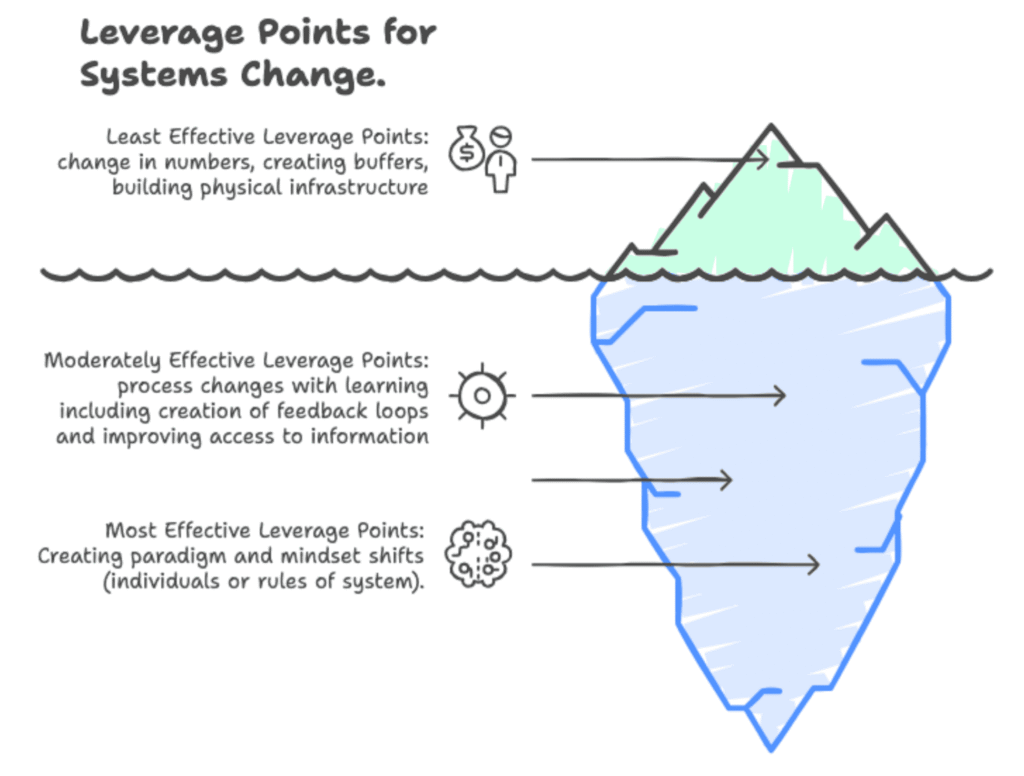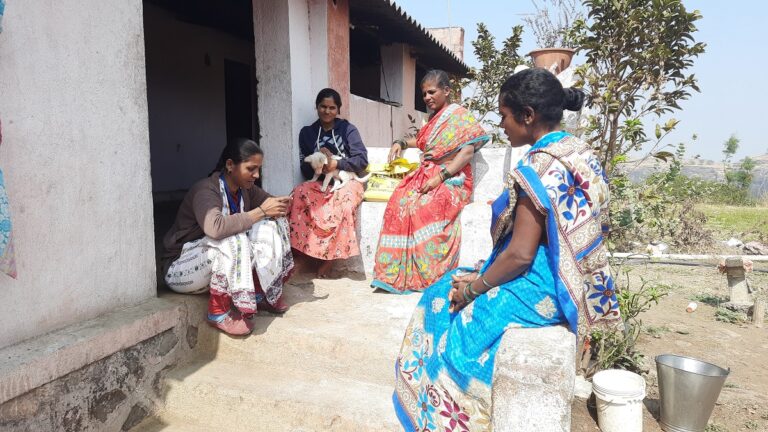AI. Machine Learning. Deep Tech. Recently, there has been a lot of buzz, and frankly, noise when it comes to the tech world. Every company, sector, and manager is trying to figure out which tool, form of integration, type of data is best suited to make them faster and more efficient. Although this does feel like the “Industrial Revolution 4.0” everyone has touted it to be, when it comes to social development, has the revolution figured out how to use it for systems change?
Systems change is a more sustainable approach to entrenched wicked problems that we try to fight in the social development world. There are many approaches, but all of them boil down to finding and effecting the key leverage points for the largest impact:

Using this approach this paper analyzes whether “Deep Tech” truly has the potential to create systems change. The NuSocia Translational Center reviewed Social Alpha’s portfolio with a Systems Change lens to find which products are better at creating change and why.
What is Deep Tech? Deep tech refers to technologies founded on tangible scientific discoveries or significant engineering breakthroughs, rather than on new business models. These innovations are focused on solving complex, fundamental global problems and are characterized by long research and development cycles, high capital needs, and the potential to create entirely new markets (disruptors). It is enabling innovators to move beyond a linear, programmatic approach to target the fundamental causes of these problems, a key driver of systems change.1 These science-led ventures are not just creating better products; they are creating the tools to re-engineer the “invisible” structures, policies, and mental models that hold “wicked problems” in place.
From Novel Products to Systemic Levers
To understand deep tech’s true impact, we must look beyond the product and analyze how it intervenes in the system. Using a systems change framework, we can see how these innovations are strategically shifting the underlying conditions that perpetuate problems.
1. Shifting Numbers & Impact Reach (Low Leverage)
Many systems are held in place by inefficient practices and broken resource flows.4 Deep tech can directly rewire these logistical and operational structures.
- Case Study: Bleetech & Flexmotiv
Startups like Bleetech (assistive hearing aids) and Flexmotiv (adaptive mobility devices) are also structural interventions. By creating low-cost, India-made alternatives, they are not just providing products; they are dismantling a structure of market exclusion that relied on high-cost, imported options. They are creating an entirely new, accessible, and affordable market structure for persons with disabilities.
2. Shifting Process Flows (Medium Leverage)
Deeper change involves shifting the structures that govern a system, such as physical access, market structures, and power dynamics.4
- Case Study: Trashin
Similarly, Trashin’s IoT-enabled tracking streamlines waste collection. It redesigns the practices of municipal waste management. By converting a fragmented, inefficient system into a data-driven, transparent one, it creates new resource flows, turning “waste” into a trackable, valuable asset for the circular economy.
3. Shifting Mental Models (High Leverage)
The most powerful and durable systems change involves shifting the deepest condition: Mental Models. This is about changing the beliefs, assumptions, and values that shape the entire system.
- Case Study: Kheyti
Kheyti’s “Greenhouse-in-a-Box” is the perfect illustration. The technology itself, a modular greenhouse that cuts water usage by 90% and protects from climate shocks, is the visible tool. But the systemic impact is the shift in the mental model of over 1,500 smallholder farmers. The dominant mental model was “farming as an act of climate-vulnerable subsistence without data, without positive learning feedback loops.” Kheyti’s innovation, bundled with training (a key in mental model shifts!) and market access, shifts this to “farming as a predictable, climate-resilient, data-driven and profitable enterprise.” This shift in mindset and agency is the true, lasting revolution.
Key Takeaways for CSR and Social Sector Leaders
The analysis showcases that deep tech can have cultural and systemic implications if implemented correctly within the context. The design, involvement of a community, training of your users all have a great impact not only on the tool’s adoption but the cultural effect it creates when it empowers the marginalized and vulnerable. CSR and Social Sector Leaders should look towards a new generation of solutions, but be mindful in how they fund, measure, and implement these tools to maximize their full potential. To meet this potential, the following checklist has been developed to cover the most glaring “need to knows”:
- Advocate for human shifts through training: Digital tools and products have the ability to bring large, scalable products once developed, but this only works if the tools are used efficiently and it empowers the correct individuals. Training is therefore the true driver of adoption and mental model shifts that bring lasting change.
- Invest in Science-for-Social-Good Ecosystems: Support incubators and accelerators like Social Alpha that nurture and connect early-stage deep tech ventures.
- Adopt Patient Capital Models: Provide long-term (5+ year), flexible, unrestricted capital to give deep tech innovators the stability to survive long R&D cycles.12
- Use Blended Finance as a Systemic Lever: Blend CSR, philanthropic, and impact investment. Use philanthropic grants as catalytic capital to “go first,” de-risk innovation, and intentionally mobilize the larger private/VC funding needed to scale.16
- Strengthen Impact Measurement for Systems: Co-create frameworks that move beyond short-term outputs. Measure the real impact: long-term, tangible shifts in the Six Conditions of Systems Change (e.g., new policies, altered resource flows, and shifted mental models).4
Works cited
- accessed on November 2, 2025, https://www.walkme.com/blog/systems-change/#:~:text=Systems%20change%2C%20or%20systemic%20change,%2C%20power%20dynamics%2C%20and%20policies.
- Systemic Change: 7 Examples You Need to Know | Robert F. Smith, accessed on November 2, 2025, https://robertsmith.com/blog/systemic-change/
- Facilitating Equitable Systems Change: – Rockefeller Philanthropy Advisors, accessed on November 2, 2025, https://www.rockpa.org/wp-content/uploads/2023/09/Facilitating_Equitable_Systems_Change.pdf
- The Six Conditions of Systems Change – Collective Impact Forum, accessed on November 2, 2025, https://collectiveimpactforum.org/wp-content/uploads/2021/12/Systems-Change-VC-Presentation-Jan-2019.pdf
- Six Conditions of Systems Change – Simon Fraser University, accessed on November 2, 2025, https://www.sfu.ca/complex-systems-frameworks/frameworks/unpacking-complexity/six-conditions-of-systems-change.html
- The Water of Systems Change – FSG, accessed on November 2, 2025, https://www.fsg.org/resource/water_of_systems_change/
- Why Proven Solutions Struggle to Scale Up, accessed on November 2, 2025, https://ssir.org/articles/entry/why_proven_solutions_struggle_to_scale_up
- Towards a shared understanding of funding systems change – Co-Impact, accessed on November 2, 2025, https://www.co-impact.org/wp-content/uploads/2020/03/Embracing-Complexity_Full-Report_final.pdf
- DAOs (Decentralized Autonomous Organizations): Do they make sense for UNICEF?, accessed on November 2, 2025, https://www.unicefventurefund.org/story/daos-decentralized-autonomous-organizations-do-they-make-sense-unicef
- What you need to know about impact investing – The GIIN, accessed on November 2, 2025, https://thegiin.org/publication/post/about-impact-investing/
- Systems Change: Insights and reflections for development practitioners, accessed on November 2, 2025, https://policy-practice.oxfam.org/resources/systems-change-insights-and-reflections-for-development-practitioners-621733/
- Seven conceptions of ‘systems change’: A starting point for intervention, accessed on November 2, 2025, https://www.sbs.ox.ac.uk/oxford-answers/seven-conceptions-systems-change-starting-point-intervention
- How it works – Ford Foundation, accessed on November 2, 2025, https://www.fordfoundation.org/work/our-grants/building-institutions-and-networks/how-it-works/
- Building institutions and networks – Ford Foundation, accessed on November 2, 2025, https://www.fordfoundation.org/work/our-grants/building-institutions-and-networks/
- Why impact investors are embracing systems change – MIT Sloan, accessed on November 2, 2025, https://mitsloan.mit.edu/ideas-made-to-matter/why-impact-investors-are-embracing-systems-change
- Why Catalytic Capital Needs a Better Definition, accessed on November 2, 2025, https://ssir.org/articles/entry/catalytic-capital-definition
- Catalytic Capital at Work – MacArthur Foundation, accessed on November 2, 2025, https://www.macfound.org/press/article/catalytic-capital-work
- Frameworks for understanding impact at scale – Social Ventures Australia, accessed on November 2, 2025, https://www.socialventures.org.au/our-impact/frameworks-for-understanding-impact-at-scale/
- The GIIN, accessed on November 2, 2025, https://thegiin.org/
- 5 challenges of evaluating systems change work and how to …, accessed on November 2, 2025, https://www.thinknpc.org/blog/systems-change-evaluation-challenges-solutions/
- Investing for Systems Change Means Refining How We Think About Impact (SSIR), accessed on November 2, 2025, https://ssir.org/articles/entry/philanthropy-impact-systems-change




